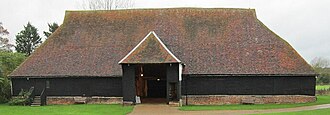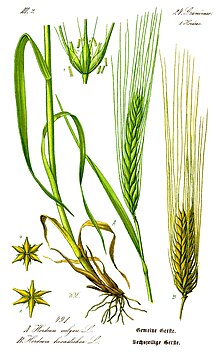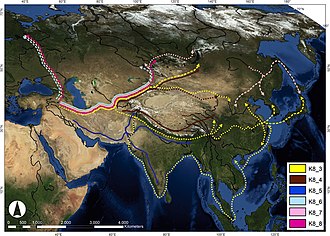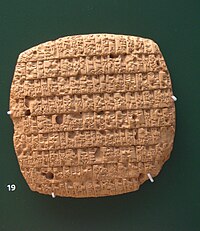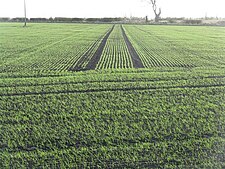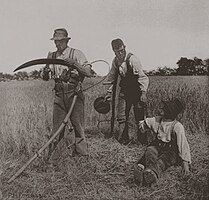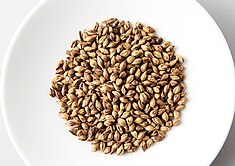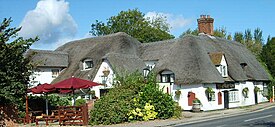
A cereal is a grass cultivated for its edible grain. Cereals are the world's largest crops, and are therefore staple foods. They include rice, wheat, rye, oats, barley, millet, and maize. Edible grains from other plant families, such as buckwheat and quinoa are pseudocereals. Most cereals are annuals, producing one crop from each planting, though rice is sometimes grown as a perennial. Winter varieties are hardy enough to be planted in the autumn, becoming dormant in the winter, and harvested in spring or early summer; spring varieties are planted in spring and harvested in late summer. The term cereal is derived from the name of the Roman goddess of grain crops and fertility, Ceres.
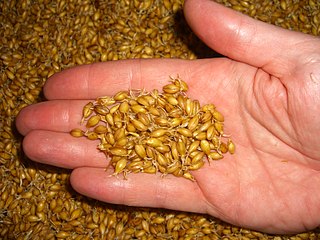
Malt is a cereal grain that has been made to germinate by soaking in water and then stopped from germinating further by drying with hot air, a process known as "malting". Malted grain is used to make beer, whisky, malted milk, malt vinegar, confections such as Maltesers and Whoppers, flavored drinks such as Horlicks, Ovaltine, and Milo, and some baked goods, such as malt loaf, bagels, and Rich Tea biscuits. Malted grain that has been ground into a coarse meal is known as "sweet meal".

Wheat is a grass widely cultivated for its seed, a cereal grain that is a worldwide staple food. The many species of wheat together make up the genus Triticum ; the most widely grown is common wheat. The archaeological record suggests that wheat was first cultivated in the regions of the Fertile Crescent around 9600 BC. Botanically, the wheat kernel is a caryopsis, a type of fruit.

The oat, sometimes called the common oat, is a species of cereal grain grown for its seed, which is known by the same name. Oats are used for human consumption as oatmeal, including as steel cut oats or rolled oats. Oats are a nutrient-rich food associated with lower blood cholesterol and reduced risk of human heart disease when consumed regularly. One of the most common uses of oats is as livestock feed.

Rye is a grass grown extensively as a grain, a cover crop and a forage crop. It is a member of the wheat tribe (Triticeae) and is closely related to both wheat and barley. Rye grain is used for flour, bread, beer, crispbread, some whiskeys, some vodkas, and animal fodder. It can also be eaten whole, either as boiled rye berries or by being rolled, similar to rolled oats.

Buckwheat or common buckwheat is a flowering plant in the knotweed family Polygonaceae cultivated for its grain-like seeds and as a cover crop. Buckwheat originated around the 6th millennium BCE in the region of what is now Yunnan Province in southwestern China. The name "buckwheat" is used for several other species, such as Fagopyrum tataricum, a domesticated food plant raised in Asia.

Hordeum is a genus of annual and perennial plants in the grass family. They are native throughout the temperate regions of Africa, Eurasia, and the Americas.

Emmer wheat or hulled wheat is a type of awned wheat. Emmer is a tetraploid. The domesticated types are Triticum turgidum subsp. dicoccum and T. t. conv. durum. The wild plant is called T. t. subsp. dicoccoides. The principal difference between the wild and the domestic forms is that the ripened seed head of the wild plant shatters and scatters the seed onto the ground, while in the domesticated emmer, the seed head remains intact, thus making it easier for humans to harvest the grain.
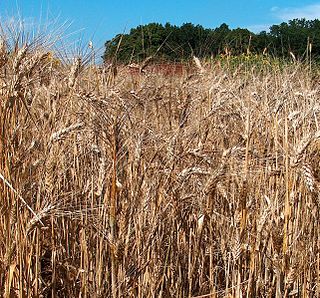
Durum wheat, also called pasta wheat or macaroni wheat, is a tetraploid species of wheat. It is the second most cultivated species of wheat after common wheat, although it represents only 5% to 8% of global wheat production. It was developed by artificial selection of the domesticated emmer wheat strains formerly grown in Central Europe and the Near East around 7000 BC, which developed a naked, free-threshing form. Like emmer, durum wheat is awned. It is the predominant wheat that grows in the Middle East.
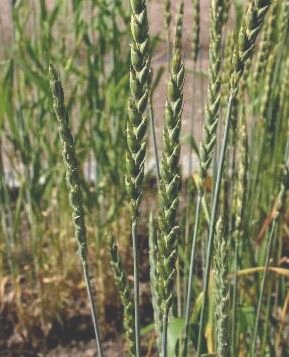
Spelt, also known as dinkel wheat or hulled wheat, is a species of wheat that has been cultivated since approximately 5000 BCE.

The founder crops or primary domesticates are a group of flowering plants that were domesticated by early farming communities in Southwest Asia and went on to form the basis of agricultural economies across Eurasia. As originally defined by Daniel Zohary and Maria Hopf, they consisted of three cereals, four pulses, and flax. Subsequent research has indicated that many other species could be considered founder crops. These species were amongst the first domesticated plants in the world.

Common wheat, also known as bread wheat, is a cultivated wheat species. About 95% of wheat produced worldwide is common wheat; it is the most widely grown of all crops and the cereal with the highest monetary yield.

Triticeae is a botanical tribe within the subfamily Pooideae of grasses that includes genera with many domesticated species. Major crop genera found in this tribe include wheat, barley, and rye; crops in other genera include some for human consumption, and others used for animal feed or rangeland protection. Among the world's cultivated species, this tribe has some of the most complex genetic histories. An example is bread wheat, which contains the genomes of three species with only one being a wheat Triticum species. Seed storage proteins in the Triticeae are implicated in various food allergies and intolerances.

Hordeum jubatum, with common names foxtail barley, bobtail barley, squirreltail barley, and intermediate barley, is a perennial plant species in the grass family Poaceae. It occurs wild mainly in northern North America and adjacent northeastern Siberia. However, as it escaped often from gardens it can be found worldwide in areas with temperate to warm climates, and is considered a weed in many countries. The species is a polyploid and originated via hybridization of an East Asian Hordeum species with a close but extinct relative of Californian H. brachyantherum. It is grown as an ornamental plant for its attractive inflorescences and when done flowering for its inflorescence.

Hordeum pusillum, also known as little barley, is an annual grass native to most of the United States and southwestern Canada. It arrived via multiple long-distance dispersals of a southern South American species of Hordeum about one million years ago. Its closest relatives are therefore not the other North American taxa like meadow barley or foxtail barley, but rather Hordeum species of the Pampas of central Argentina and Uruguay. It is less closely related to the Old World domesticated barley, from which it diverged about 12 million years ago. It is diploid.
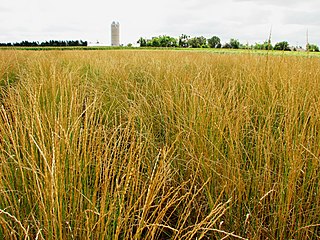
Thinopyrum intermedium, known commonly as intermediate wheatgrass, is a sod-forming perennial grass in the Triticeae tribe of Pooideae native to Europe and Western Asia. It is part of a group of plants commonly called wheatgrasses because of the similarity of their seed heads or ears to common wheat. However, wheatgrasses generally are perennial, while wheat is an annual. It has gained the Royal Horticultural Society's Award of Garden Merit as an ornamental.

Bere, pronounced "bear," is a six-row barley currently cultivated mainly on 5-15 hectares of land in Orkney, Scotland. It is also grown in Shetland, Caithness and on a very small scale by a few crofters on some of the Western Isles, i.e. North Uist, Benbecula, South Uist, Islay and Barra. It is probably Britain's oldest cereal in continuous commercial cultivation.

Hordeum spontaneum, commonly known as wild barley or spontaneous barley, is the wild form of the grass in the family Poaceae that gave rise to the cereal barley. Domestication is thought to have occurred on two occasions, first about ten thousand years ago in the Fertile Crescent and again later, several thousand kilometres further east.

Ancient grains is a marketing term used to describe a category of grains and pseudocereals that are purported to have been minimally changed by selective breeding over recent millennia, as opposed to more widespread cereals such as corn, rice and modern varieties of wheat, which are the product of thousands of years of selective breeding. Ancient grains are often marketed as being more nutritious than modern grains, though their health benefits over modern varieties have been disputed by some nutritionists.
Golden Promise is a variety of spring-sown two-row barley. It was developed in the 1950s by exposing an existing variety to gamma radiation with the aim of producing a semi-dwarf variety of barley that had good malting characteristics. It became very popular with farmers during the 1970s but began to be replaced by higher yielding varieties in the 1980s. Due to its perceived better flavour than these more modern varieties, a niche market was maintained and it is still favoured by craft brewers. It has been used by researchers to study the genetics of barley and to investigate the effect of barley on the flavour of beer.

